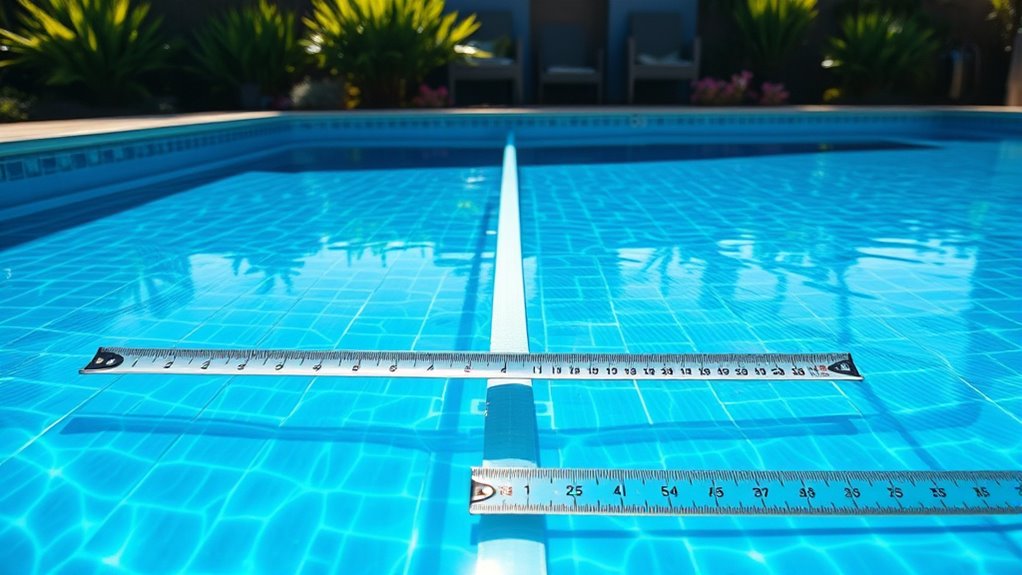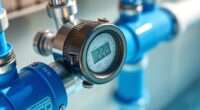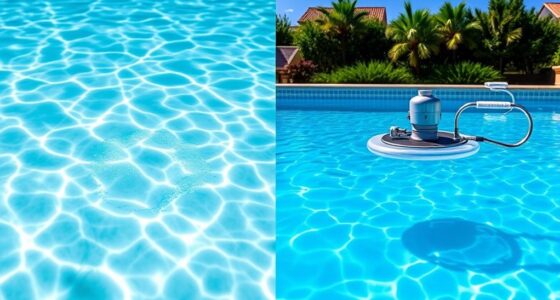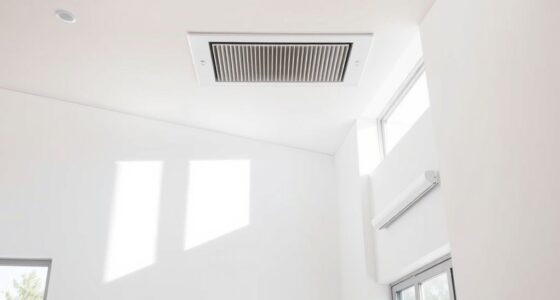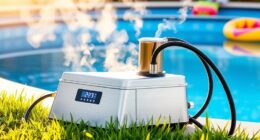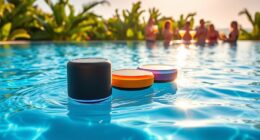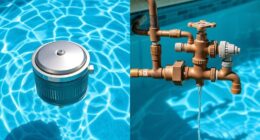To calculate your pool’s exact volume, start by measuring its length, width, and depth at multiple points for accuracy. For rectangular pools, multiply length by width, then by the average depth; for circular pools, multiply pi by the radius squared and by the average depth. Adjust the calculation for shapes like oval or kidney pools using specific formulas. Accurate measurements are key, and if you keep going, you’ll discover more tips for precise results.
Key Takeaways
- Measure your pool’s length, width, and depth at multiple points for accuracy.
- Calculate the volume using shape-specific formulas (rectangular, circular, oval) based on your measurements.
- Determine the average depth by averaging multiple depth readings across different pool areas.
- Convert the calculated cubic footage into gallons or liters using the appropriate conversion factors.
- Use online pool volume calculators or tools to verify your manual calculations for precision.
Measure the Length of Your Pool
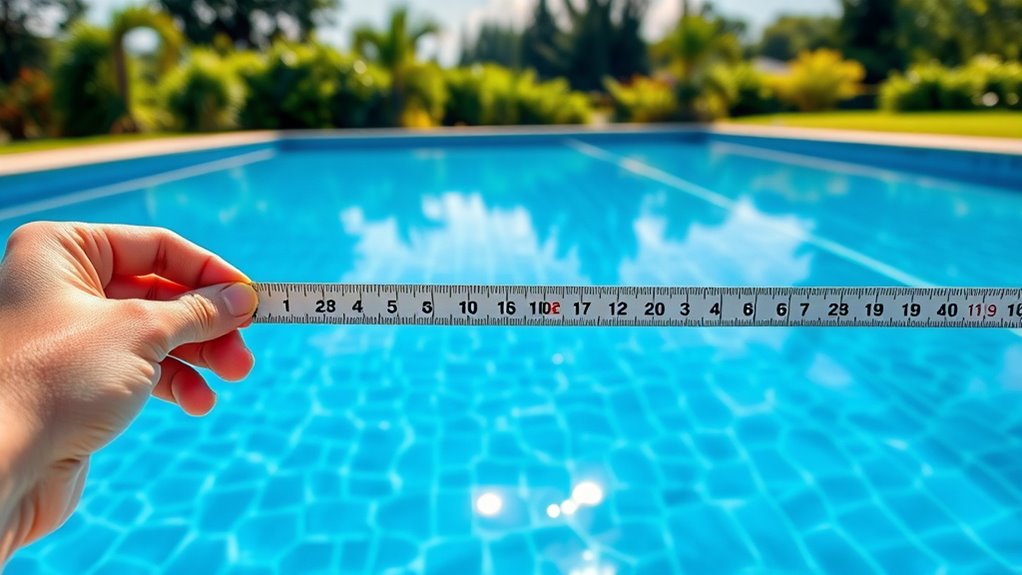
To accurately determine your pool’s volume, start by measuring its length. Use a sturdy tape measure to get an exact measurement from one end to the other. Accurate measurements are essential for proper pool maintenance, ensuring you use the right chemicals and treatments. When measuring, keep the tape straight and flat against the pool’s surface for precision. Always prioritize safety precautions—wear gloves if needed and avoid slipping on wet surfaces. Knowing your pool’s length helps you calculate its volume more accurately, especially when combined with width and depth. This step lays the foundation for effective water management, saving you time and money in the long run. Additionally, understanding your pool’s dimensions can assist in return policies if you decide to upgrade or replace equipment. Understanding your pool’s size also supports proper chemical dosing, ensuring water quality and safety are maintained efficiently. Moreover, having precise measurements can improve overall water balance, which is vital for preventing issues like algae growth and equipment corrosion. Being aware of your pool’s dimensions can also help you plan for maintenance schedules, making it easier to keep your pool in optimal condition. Recognizing your pool’s specific measurements can also aid in selecting the right tuning equipment if you decide to upgrade your pool’s features or accessories.
Measure the Width of Your Pool
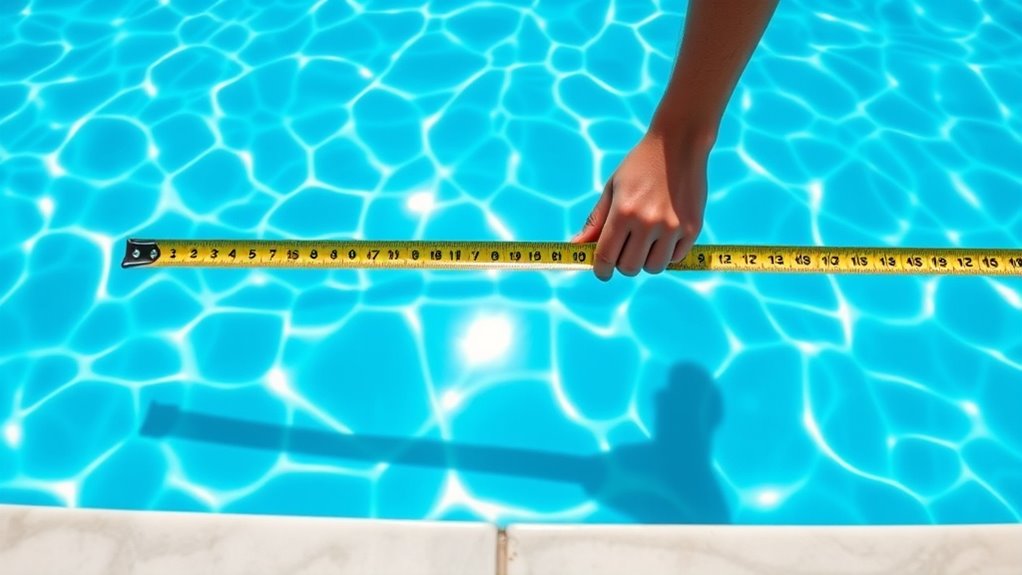
Grab a measuring tape and extend it across the widest part of your pool. Make sure to record the measurement at the point where the pool is broadest. Accurate width measurement is key to calculating your pool’s total volume correctly. For better results, consider measuring during low wind conditions to avoid inaccuracies caused by movement or water surface disturbances. Additionally, ensuring your self watering plant pots are filled properly can help maintain healthy plant growth around your pool area. Checking the expiration date of any pool chemicals used can also ensure safety and effectiveness during maintenance. Regularly inspecting your pool’s calibration can help maintain measurement accuracy over time.
Use a Measuring Tape
Using a measuring tape is a straightforward way to determine your pool’s width accurately. First, verify the area around your pool is clear of obstructions. Then, follow these steps:
- Extend the tape across the widest part of the pool, from one edge to the opposite.
- Keep the tape level and straight, avoiding sagging or slack.
- Hold the tape firmly at both ends to prevent movement.
- Read the measurement at the point where the tape contacts the pool’s edge.
- Ensuring your workspace is organized and free of distractions can improve your productivity when taking measurements. Additionally, for precise volume calculations, knowing the dimensions of your pool is essential. Properly measuring the shape of your pool can also impact the accuracy of your volume estimate. To enhance your measurement process, consider the electric tools that can assist with more complex pool shapes.
Record the Widest Point
After extending the measuring tape across the widest part of your pool, make sure you record the measurement accurately. This step is vital for precise volume calculations, which are essential for proper pool maintenance. Confirm the tape stays straight and flat to avoid inaccurate readings. Keep safety precautions in mind—be cautious around wet surfaces to prevent slips or falls. If your pool has irregular shapes, measure the widest point carefully, as this will impact your overall calculations. Recording this measurement correctly helps you determine the total volume and guarantees effective chemical balancing and water treatment. Additionally, understanding the safety features of your pool equipment and accessories can contribute to a safer swimming environment. Taking precise measurements now saves you time and effort later, leading to safer, cleaner, and well-maintained pool conditions. Remember that understanding celebrity lifestyle insights can also inspire unique design ideas for your pool area.
Determine the Average Depth

To accurately determine your pool’s volume, you first need to find its average depth. This involves measuring the depth at multiple points to get an accurate reading. Imagine you’re standing at the shallow end, then moving to the middle, and finally measuring the deep end. To visualize this, consider:
Measuring depths at various points helps find your pool’s true average for accurate volume calculation.
- Measuring the shallow end, where water is just a few feet deep.
- Moving to the middle, where the depth increases gradually.
- Checking the deep end, which might be over six feet deep.
- Taking multiple readings to guarantee consistency.
- Understanding how automation in business can help streamline data collection and analysis for more precise measurements. Incorporating digital measurement tools can further enhance accuracy and reduce manual errors. Utilizing advanced measurement techniques can also help account for irregular pool shapes and uneven surfaces. Additionally, using specialized software designed for volume calculations can simplify complex measurements and improve overall accuracy.
Calculate the Pool’s Volume for a Rectangular Shape
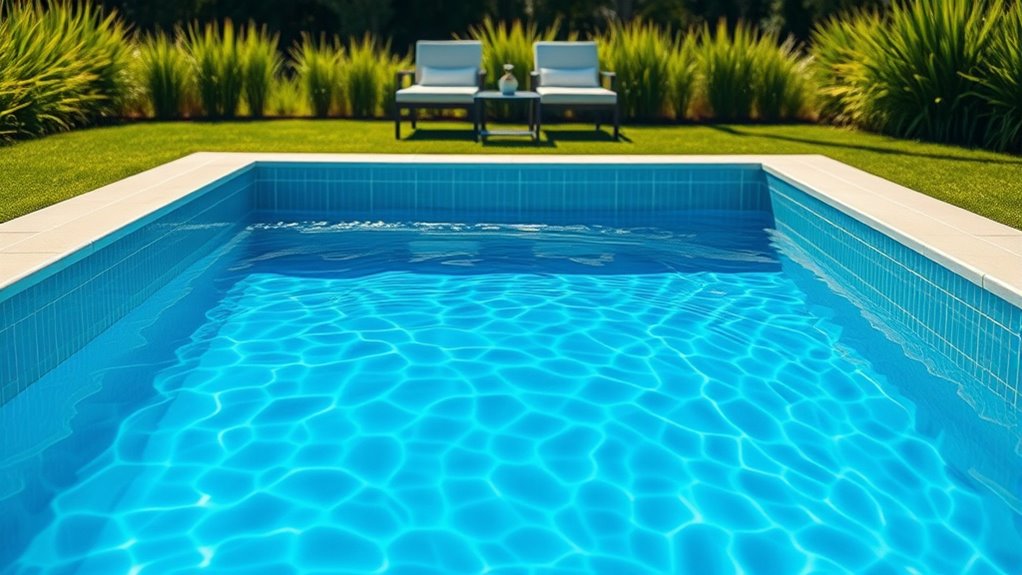
To calculate your rectangular pool’s volume, start by measuring its length, width, and average depth. Then, use the simple formula: length x width x depth to find the cubic footage. Finally, convert that number into gallons to know your pool’s exact capacity.
Measure Pool Dimensions
Measuring the dimensions of your rectangular pool accurately is essential for calculating its volume. First, guarantee the pool is clean and free of debris to avoid measurement errors. Next, use a tape measure to record the length, width, and average depth. Be precise, noting measurements to the nearest inch or centimeter. To visualize:
- Picture yourself standing at one end, stretching the tape along the length.
- Move to the side to measure the width, keeping the tape straight.
- Use a ruler or measuring stick to find the deepest and shallowest points, then average them.
- Double-check measurements to ensure accuracy, which is crucial for proper pool maintenance and safety considerations. Accurate dimensions help prevent over- or underestimating volume, ensuring safe chemical levels and water quality.
Calculate Volume Formula
Since you’re working with a rectangular pool, calculating its volume is straightforward once you have the measurements. To find the volume, multiply the length by the width and then by the average depth. This gives you the total cubic feet of water in the pool. Knowing the precise volume is essential for efficient pool maintenance and maintaining proper water chemistry. Accurate measurements guarantee you add the right amount of chemicals and avoid issues like algae growth or pH imbalance. Keep in mind that even small miscalculations can affect water quality and the effectiveness of your cleaning routines. Using the correct volume formula helps you manage your pool better, keeping the water balanced, safe, and inviting for swimming.
Convert to Gallons
Ever wondered how to convert your pool’s volume from cubic feet to gallons? It’s simple once you visualize the process:
- Imagine a container holding your pool’s cubic footage.
- Think of the conversion factor, where 1 cubic foot equals 7.48 gallons.
- Picture multiplying your calculated cubic feet by 7.48 to find gallons.
- Envision guaranteeing your pool’s chemical balance stays safe during this process.
Knowing your pool’s exact gallon amount helps you maintain proper chemical levels and follow safety precautions. Accurate conversion prevents over- or under-shocking, which can impact pool chemical balance and safety. Always double-check your calculations to ensure your pool remains safe, clean, and balanced, making your swimming experience enjoyable for everyone.
Adjust for Non-Rectangular Pools

When dealing with non-rectangular pools, you need to adjust your calculations to account for their irregular shapes. Instead of simple length, width, and depth measurements, break the pool into sections like triangles, circles, or irregular shapes. Measure each section’s dimensions accurately, then calculate their individual volumes using appropriate formulas. Add these volumes together to find the total pool capacity. This precise measurement helps with pool maintenance, ensuring you add the right amount of chemicals or water. Always prioritize safety precautions when working around the pool, especially if you’re using tools or climbing into areas for measurements. Accurate volume calculations prevent overfilling or under-filling, keeping the pool safe and well-maintained for everyone.
Convert Cubic Feet to Gallons or Liters

To accurately determine your pool’s volume in gallons or liters, you need to convert from cubic feet, which is the common unit for measurements. Visualize these steps:
- Imagine a cube measuring 1 foot on each side, holding 7.48 gallons or 3.785 liters.
- Picture filling a cube with water, then pouring that water into your pool.
- Think of multiplying your pool’s cubic footage by 7.48 to get gallons, or by 3.785 for liters.
- Envision using this number to adjust your pool’s water chemistry and maintain proper pH, alkalinity, and sanitizer levels.
This conversion is essential for accurate pool maintenance, ensuring your water chemistry stays balanced and safe for swimming.
Use a Pool Volume Calculator (Optional)
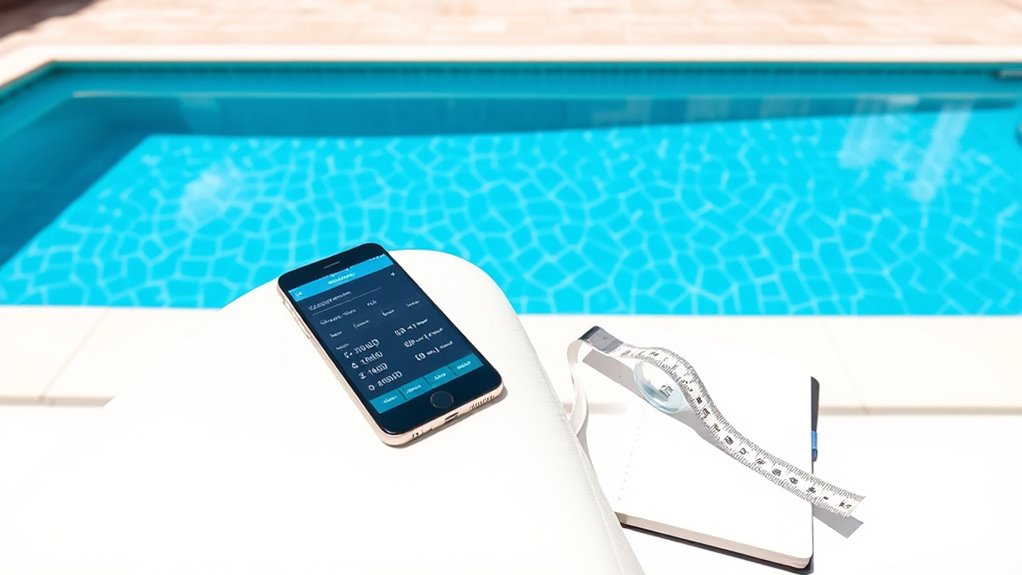
Using a pool volume calculator simplifies the process of determining your pool’s exact size without complex math. These tools are especially helpful for accurate measurements, ensuring proper pool maintenance and chemical balancing. By inputting basic dimensions, a calculator quickly provides your pool’s volume in gallons or liters, saving you time and effort. When using a calculator, always double-check measurements to maintain safety precautions, such as avoiding overflows or chemical imbalances. This method reduces errors and helps you plan maintenance tasks more effectively. Keep in mind, while optional, a pool volume calculator enhances precision, making it easier to keep your pool safe, clean, and well-maintained. It’s a practical tool for homeowners who want quick, reliable results without fuss.
Account for Different Pool Shapes (Oval, Kidney, Etc.)
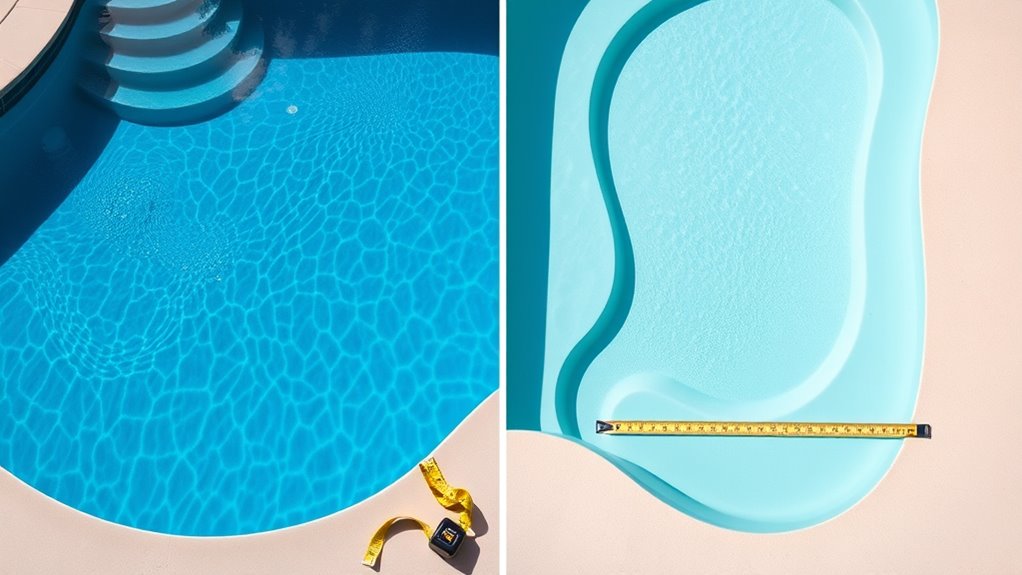
Different pool shapes like oval, kidney, or freeform require tailored calculations because their volumes don’t match standard rectangular or circular formulas. To accurately determine your pool’s volume, visualize these shapes:
Understanding different pool shapes like oval, kidney, or freeform is essential for accurate volume calculations.
- An elongated oval with smooth curves stretching across your yard.
- A kidney-shaped pool with a narrow waist and rounded edges.
- A freeform pool with irregular, flowing contours mimicking natural water bodies.
- A multi-section design combining curves and straight sides.
Use specific formulas for each shape, adjusting measurements accordingly. Knowing your pool’s exact volume aids in proper pool maintenance, ensuring chemical levels are balanced. Always follow safety precautions when measuring or working around your pool to prevent accidents during calculations or cleaning.
Verify Your Measurements for Accuracy
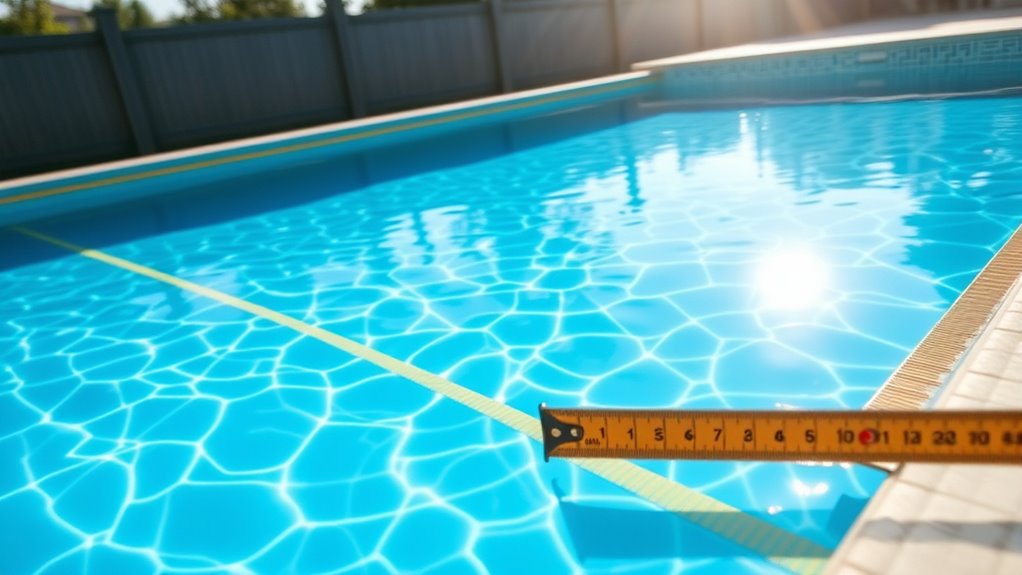
Before calculating your pool’s volume, it’s essential to verify that your measurements are accurate. Double-check the length, width, and depth with a reliable tape measure, ensuring it’s straight and not slack. Small errors in measurements can lead to incorrect volume calculations, affecting your pool chemistry adjustments. Accurate measurements help you maintain proper chemical balance and prevent issues like algae growth or corrosion. Remember to record measurements at multiple points, especially if your pool has uneven depths or irregular shapes. As you do this, keep safety tips in mind—use stable ladders and avoid slipping. Precise measurements ensure safe, effective pool maintenance and help you avoid costly mistakes when balancing chemicals and managing water quality.
Keep Record of Your Calculations
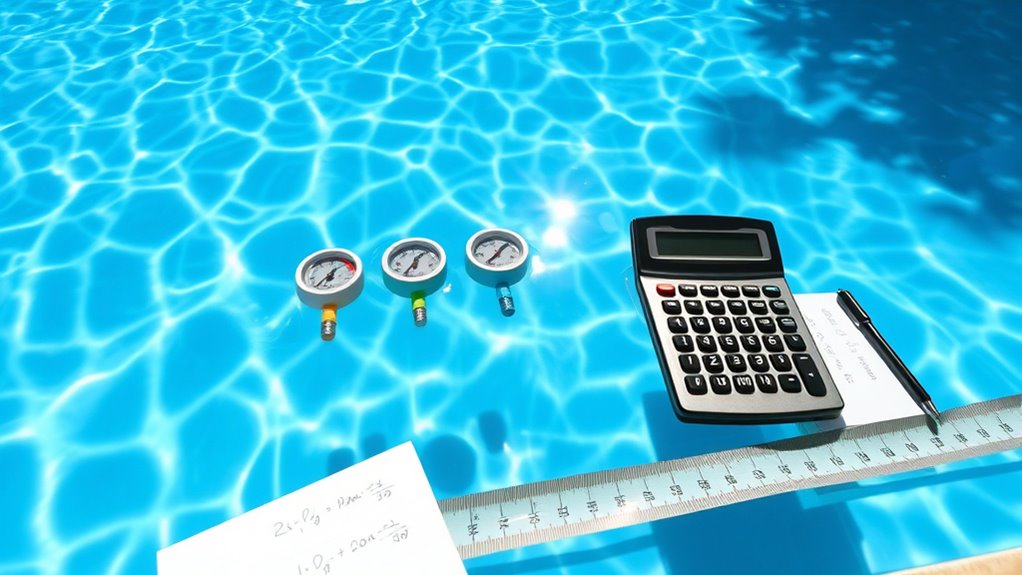
You should keep a record of your calculations to guarantee accuracy and consistency. Document your measurements so you can reference them later or identify any discrepancies. Tracking changes over time helps you understand how your pool’s volume might fluctuate.
Document Your Measurements
Keeping a detailed record of your measurements and calculations is essential for accurately determining your pool’s volume. Precise documentation helps track water chemistry and simplifies pool maintenance. To stay organized, imagine your notes as a clear blueprint:
- Write down each measurement (length, width, depth) with dates.
- Record your calculation steps for transparency.
- Note any adjustments or corrections made.
- Keep a log of water test results to monitor chemistry changes.
Visualizing this, your records become a reliable reference for ongoing pool care. Accurate documentation guarantees you can identify when water chemistry shifts or maintenance is needed, preventing costly errors. By maintaining detailed logs, you stay proactive, ensuring your pool remains clean, safe, and balanced.
Track Changes Over Time
Maintaining detailed records of your measurements and calculations allows you to monitor how your pool’s volume changes over time. Regularly tracking these figures helps identify shifts that could impact pool maintenance and water chemistry. If your volume decreases, you might need to check for leaks or evaporation issues. Conversely, an increase could indicate debris buildup or other problems. Keeping a log of your calculations also guarantees consistency in your maintenance routine, making it easier to adjust chemical balances accurately. Over time, this record helps you spot patterns and anticipate maintenance needs, saving you time and costs. By staying organized and attentive to changes, you ensure your pool remains safe, clean, and properly balanced, enhancing your overall swimming experience.
Frequently Asked Questions
How Often Should I Recalculate My Pool’S Volume?
You should recalculate your pool’s volume whenever you notice water levels change considerably, like from water evaporation or adding a large amount of water. Regularly checking helps you maintain proper pool chemicals balance and guarantees accurate chemical dosing. If you notice unexplained water loss or after heavy rain, it’s a good idea to recalculate. Keeping your pool’s volume accurate helps prevent issues and keeps your water safe and clean.
What Tools Are Best for Measuring Irregular Pool Shapes?
When measuring irregular pool shapes, you want tools that improve pool shape estimation and measurement accuracy. Use a flexible measuring tape for dimensions, and a waterproof sketch pad to map out the shape. A laser distance meter offers precise measurements for complex angles. Combining these tools helps you accurately estimate your pool’s volume, ensuring calculations reflect its true shape, making maintenance and chemical balancing easier.
How Do Temperature Changes Affect Volume Calculations?
A stitch in time saves nine, and understanding how temperature changes affect your pool is vital. Temperature expansion causes water to expand, increasing volume, while volume contraction occurs as it cools. These fluctuations can slightly alter your pool’s measurements, so consider the water’s temperature when calculating volume for accuracy. Monitoring temperature variations helps you maintain precise water levels and optimize chemical use, ensuring your pool stays in perfect condition.
Can I Estimate Volume Using Water Level Markers?
You can estimate your pool’s volume using water level markers, but keep in mind that water level accuracy is key. For better results, consider the pool shape estimation—rectangular, circular, or irregular shapes influence your measurement. Mark consistent water levels, record the measurements, and use basic formulas for your pool shape. This method provides a rough estimate, but for precision, more detailed calculations or measurements are recommended.
What Safety Precautions Should I Take During Measurements?
Think of measuring your pool like tending a delicate garden—you need care and caution. During measurements, wear sturdy gloves and safety goggles to avoid slips or splashes. Make certain your pool is empty of debris to prevent accidents. Regular pool maintenance and proper chemical balancing keep everything safe. Keep a clear pathway, and never lean too far over the edge. These precautions help you stay safe while accurately evaluating your pool’s volume.
Conclusion
By mastering the art of measuring your pool, you’re fundamentally unlocking its hidden heartbeat—its true volume. When you accurately chart its dimensions, you’re painting a clear map to its core, transforming numbers into a symphony of water and geometry. Think of it as decoding a secret language, where every measurement whispers the story of your pool’s capacity. With these insights, you hold the power to keep your aquatic haven perfectly balanced—your very own liquid masterpiece.
